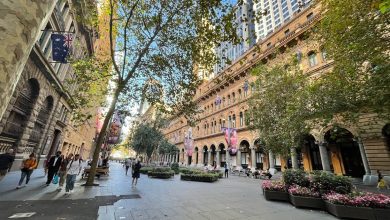
McEvoy: “Remarkably Good Year” for Tourism
Tourism Australia managing director Andrew McEvoy has described 2011 as a “remarkably good year” for the tourist industry as the body hit back at claims the sector is struggling.
His comments follow the release of quarterly figures that show an overall increase in visitor arrivals in the year to June of 3%, fuelled by a 9% rise in business visitors. The figures, though, only reflect an increase over the disastrous 2010 arrival numbers.
Expenditure and visitor nights also increased, by 5% and 4% respectively, according to the International Visitor Survey. Holiday arrivals did slip back.
Mr McEvoy said the figures, compiled by Tourism Research Australia, flew in the face of recent negativity from the industry.
“Despite the regular reports of doom and gloom, the fact is that 2011 has been a remarkably good year so far for Australia tourism, borne out by the latest figures,” Mr McEvoy said. “Overall, tourism to Australia is growing despite a strong Aussie dollar, difficult macro economic conditions in our key western markets, the challenges of flooding and cyclones at home and the devastating earthquakes in New Zealand and Japan.”
The increase in spending was “particularly pleasing”, he said.
Federal tourism minister Martin Ferguson also welcomed the report, urging Australians to holiday at home. But he noted: “Domestic tourism makes up three quarters of the sector and some parts of Australia are still doing it tough”.
“So Australians need to balance out the appeal of overseas travel with Australian holiday breaks to support the sector that directly employs half a million Australians.” He urged Australians to resist the temptation of cheap overseas trips.
Mr McEvoy said Asia Pacific nations — notably China, Malaysia, India, Singapore, Indonesia and New Zealand – continue to drive the growth. He added the longer haul UK, Europe and US markets, still in the grip of ongoing financial difficulties, had small declines.
“Asian visitors, particularly those from China, spend significant amounts of money during their visit to Australia and the tourism industry must harness this spend to its advantage,” Australian Tourism Export Council boss Felicia Mariani said.
Ms Mariani said it was pleasing to see visitors were spending time in regional areas with 32% travelling outside major cities, 51% of those visiting NSW, 36% going to Queensland and 32% to Victoria.
“Backpacker numbers have held steady at around 583,000 to the year ending June 2011 but their value continues to be under acknowledged,” she said. “They travel widely through regional parts of Australia, they often work here, encourage family and friends to visit, stay nearly three times as long as holidaymakers and spend almost as much per day.”
Quarterly International Visitor Survey figures show that overall expenditure and the length of stay of international guests have increased apart from in the backpacker market, where numbers have slightly decreased, despite good showings from Victoria, WA and Tasmania. Queensland experienced the biggest drop in backpacker numbers.
Tasmania performed well in terms of backpacker arrivals (+11.1%) as did Victoria (+1.3%) and Western Australia (+1.08%) all outperforming the national average. While backpacker numbers dropped in NSW (-3.5%), Queensland (-10%), South Australia (-11%) and the Northern Territory (-11%). Of all backpackers, 76% visited New South Wales, 57% visited Queensland and 45% visited Victoria.
The Tourism and Transport Forum said rises in spending in Australia helped offset the impact of the Queensland floods and earthquakes in Japan and New Zealand. But TTF boss John Lee said there were signs of weakness in key areas including education. Spending by education visitors rose just 0.2 % for the quarter but Mr Lee says the visitors are important because of the longer time they stay in the country. He says global economic conditions are having a two-fold effect. “European and American economies are struggling and the rising Australian dollar has meant people are less prepared to come to Australia.”
Total visitors were 5.46 million, up 3% with holiday travel making up 45% of those, visiting friends and relatives 25%, business 16%, education 8%, employment 2% and other 4%.
Leading country of origins were New Zealand (1,072,955), followed by UK (595,554), China (474,607), and USA (434,600).
Spending averaged $3344 per person (or $96 per night). International visitors spent approximately 83% of their expenditure in the capital cities and the Gold Coast ($14.9 billion). The Northern Territory was the most reliant on expenditure in regional areas (64%), followed by Tasmania (46%) and Queensland (38%).
The news was not so good for Queensland with fewer international travellers visiting the state last financial year. Tourism Queensland says 753,000 international visitors visited the Gold Coast, a 9% drop on the previous 12 months. Every other Queensland region saw drops of at least 7% except Brisbane, where business travel fuelled growth.
The figures show there was a 1% drop – to 649,000 – in overseas visitors to Cairns in the state’s far north.
Tourism Queensland’s Jeff Gillies says new flights from Japan and New Zealand protected the far north from a larger fall in numbers.
The healthy visitor numbers from China, India, Indonesia and Thailand revealed last week by the International Visitor Survey, are a “strong endorsement” of the government’s focus on these emerging markets, Ms Mariani claimed. But she added that the challenge was now to “take full advantage of the possibilities”.
“Asian visitors, particularly those from China, spend significant amounts of money during their visit to Australia and the tourism industry must harness this spend to its advantage,” Ms Mariani said. “With significant increases in arrivals and spend from these four markets, we have a real opportunity to carve out a strong identity that maintains and grows the number of visitors for decades to come.”

AccomNews is not affiliated with any government agency, body or political party. We are an independently owned, family-operated magazine.







